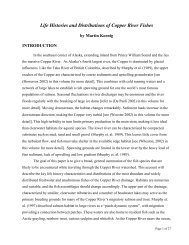Mitigation for the Construction and Operation of Libby Dam
Mitigation for the Construction and Operation of Libby Dam
Mitigation for the Construction and Operation of Libby Dam
You also want an ePaper? Increase the reach of your titles
YUMPU automatically turns print PDFs into web optimized ePapers that Google loves.
spacing was 172.8 feet, which represented a 46.9% reduction in <strong>the</strong> distance between pools.<br />
Pool spacing measurements in 2003 represented a complete sampling <strong>of</strong> all pools present<br />
during both years. However, <strong>the</strong> measurements collected in 1999 represented a sampling <strong>of</strong> <strong>the</strong><br />
pools. We conducted a t-test <strong>and</strong> concluded that <strong>the</strong> distance between pools decreased<br />
significantly as a result <strong>of</strong> project construction (p < 0.05).<br />
In 1999, prior to project construction, we measured stream channel morphology at 5<br />
cross-sectional survey locations in riffle habitat within <strong>the</strong> project area. After project<br />
construction in 2002 we established 9 permanent transects in riffle habitats. These same<br />
locations were surveyed again in <strong>the</strong> summer <strong>of</strong> 2003, after <strong>the</strong> project had experienced <strong>the</strong> first<br />
spring freshet. At each transect we measured mean bankfull width, depth, width to depth ratio,<br />
<strong>and</strong> cross sectional area. We used analysis <strong>of</strong> variance (ANOVA) <strong>and</strong> a subsequent multiple<br />
comparison test (Fisher’s Least Significant Difference; Zar 1996) to test <strong>for</strong> significant<br />
differences between years (alpha = 0.05; Table 2). Mean bankfull width, depth, <strong>and</strong> width to<br />
depth ratio were significantly reduced from 1999 to 2002 <strong>and</strong> 1999 to 2003. Comparisons <strong>for</strong><br />
<strong>the</strong> three parameters between 2002 <strong>and</strong> 2003 were not significantly different (p > 0.05; Table<br />
2). However, <strong>the</strong> associated variance <strong>for</strong> each <strong>of</strong> <strong>the</strong> 4 parameters decreased each year (Table<br />
2).<br />
Due to <strong>the</strong> importance <strong>of</strong> pool habitat to rearing redb<strong>and</strong> <strong>and</strong> bull trout within <strong>the</strong><br />
project area, we devoted a substantial ef<strong>for</strong>t to monitor pool habitat after project construction to<br />
evaluate whe<strong>the</strong>r <strong>the</strong> pools maintained depth, width <strong>and</strong> length through time. After project<br />
construction in <strong>the</strong> fall <strong>of</strong> 2002, we measured mean bankfull depth, width, length <strong>and</strong> maximum<br />
bankfull depth <strong>of</strong> <strong>the</strong> 20 pools constructed in <strong>the</strong> project area. We repeated <strong>the</strong>se measurements<br />
in <strong>the</strong> summer <strong>of</strong> 2003 after <strong>the</strong> project had experienced <strong>the</strong> first spring freshet. We did not<br />
per<strong>for</strong>m a statistical comparison <strong>for</strong> <strong>the</strong>se data because <strong>the</strong> pool measurements represented all<br />
pools within <strong>the</strong> project area (i.e. complete census), making statistical comparisons<br />
unnecessary. We observed a decrease in <strong>the</strong> mean values <strong>of</strong> each <strong>of</strong> <strong>the</strong> 4 parameters from<br />
2002 to 2003 (Table 3). Mean bankfull depth showed <strong>the</strong> sharpest decline (18%) from 2002 to<br />
2003, followed by pool length, which decreased by 17.7% (Table 3). The variance <strong>of</strong> each <strong>of</strong><br />
<strong>the</strong> 4 parameters also decreased from 2002 to 2003 (Table 3). The mean annual variance <strong>for</strong><br />
mean bankfull depth had <strong>the</strong> highest decrease (18%) between 2002 <strong>and</strong> 2003, followed by<br />
maximum bankfull depth variance, which decreased by 40.4% (Table 3). Although mean pool<br />
length decreased by 17.7%, <strong>the</strong> total proportion <strong>of</strong> pool habitat (sum <strong>of</strong> all pool lengths divided<br />
by total project area stream length) within <strong>the</strong> project area decreased by 4%, from 22% in 2002<br />
to 18% in 2003.<br />
In addition to a complete census <strong>of</strong> all pools within <strong>the</strong> project area, we also surveyed<br />
all 13 riffles within <strong>the</strong> project area to evaluate changes in riffle slope through time. The postconstruction<br />
mean riffle slope in 2002 was 1.95% (variance = 7.79*10 -5 ), which decreased by<br />
33.3% in 2003 to a mean riffle slope <strong>of</strong> 1.30% (variance = 2.033*10 -5 ). We attribute <strong>the</strong> overall<br />
flattening <strong>of</strong> <strong>the</strong> riffles within this project to 2 factors. Fur<strong>the</strong>r examination <strong>of</strong> our survey<br />
in<strong>for</strong>mation revealed that <strong>the</strong> top end <strong>of</strong> our riffles generally incised within <strong>the</strong> channel<br />
(degraded) due in part to <strong>the</strong> scour achieved below many <strong>of</strong> <strong>the</strong> gradient control cobble<br />
structures installed at <strong>the</strong> tailout area <strong>of</strong> many <strong>of</strong> <strong>the</strong> pool structures. The lower portion <strong>of</strong><br />
126
















